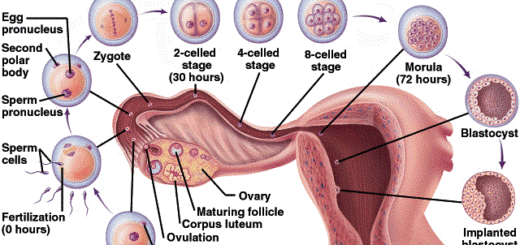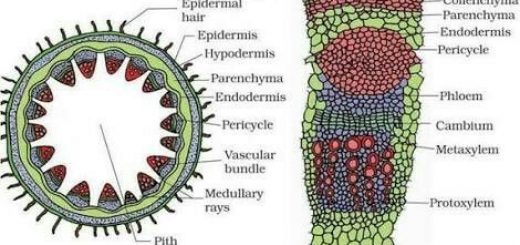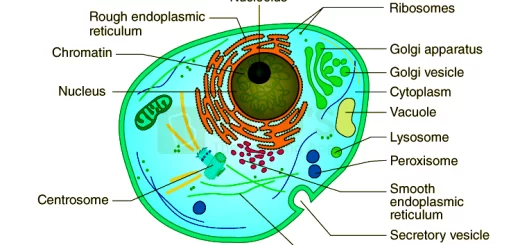Genes, Chromosomes, Proteins, Bacteriophages and Quantity of DNA in the cells
The nucleus is responsible for governing the transfer of inherited characters from parents to offsprings, as it contains the genetic information which is called genes, These genes are carried on the chromosomes, During cell division (mitosis), the chromosomes in the nucleus are separated from each other, and at the end each cell contains the same number of chromosomes found in the original cell, this convinced that chromosomes are the bearers of genetic information.
Efforts of scientists to determine the genetic material of living organisms
Genes are the units of genetic information that control the inherited characters, The chromosomes are composed of two substances, which are DNA and proteins, Scientists thought at first that proteins carry the genetic information and not DNA due to the following reasons:
- Proteins contain 20 different kinds of amino acids in different combinations which suit the variation of the genetic information.
- DNA contains only four kinds of nucleotide monomers.
But in 1940, this thought was shown to be wrong and scientists discovered that DNA is the genetic material, that in turn led the scientists to study the molecular basis of inheritance often called molecular biology, one of the most exciting and fast-growing fields of the modern science, Molecular biology is one of the most exciting and fast-growing fields of the modern science, where it is interested in the study of the molecular basis of inheritance.
Evidences that DNA is the genetic material
- Bacterial transformation.
- Bacteriophages.
- Quantity of DNA in the cells.
Bacterial transformation
Griffith’s experiment
Griffith made his experiment in 1928 on mice using two types of a strain of bacteria causing pneumonia which are (S) strain and (R) strain, as follows:
- Injecting a group of mice with the bacterial strain (S), Mice were infected with pneumonia and died, Bacterial strain (S) is virulent (mice were died by pneumonia).
- Injecting another group of mice with the bacterial strain (R), Mice were infected with pneumonia but they remained alive, Bacterial strain (R) is non-virulent (mice were infected only with pneumonia and didn’t die).
- Injecting another group of mice with the bacterial strain (S) that had been killed by heating, The mice didn’t die, Bacterial strain (S) that had been killed by heating didn’t cause the death of mice.
- Injecting another group of mice with non-living virulent bacterial strain (S) that was killed by heating and living non-virulent bacterial strain (R), Some mice died, By examining the dead mice, he found that they contained living virulent bacteria (S), as some of the genetic materials of the virulent bacterial strain (S) had entered the non-virulent ones (R), transforming them to the virulent form (S).
Griffith named the phenomenon of transformation of the non-virulent bacteria (R) into virulent bacteria (S) with bacterial transformation, but he didn’t explain how the genetic material was transferred from bacteria (S) to bacteria (R), Bacterial transformation is the transformation of a strain of bacteria (non-virulent strain R) to another strain of bacteria (virulent strain S), due to the transfer of the genetic material to it.
Avery and his colleagues’ experiment
- Avery and his colleagues isolated the bacterial transforming material from the virulent bacteria (S) that was capable of inducing the genetic transformation in the non-virulent bacteria (R).
- They analyzed this material.
Conclusion: The chemical and physical analysis shows that this material is DNA.
The general explanation of the bacterial transformation: A strain of bacteria (R) absorbed the DNA of another bacterial strain (S) and gained its characteristics, and these transformation characteristics were transferred to the next generations.
An objection was carried out at first on that DNA is the genetic material: The DNA that caused the bacterial transformation was not pure enough and was contaminated with protein, perhaps this protein was the transforming material.
Crucial experiment
- The transforming material (DNA + protein) was treated with deoxyribonuclease enzyme that hydrolyzes the DNA completely, but it doesn’t affect the proteins or RNA.
- This material was transferred to the non-virulent bacterial strain (R).
Observation: The non-virulent bacteria (R) didn’t transform into the virulent bacteria (S), The bacterial transformation didn’t occur due to the absence of DNA that was hydrolyzed.
Conclusion: DNA is the genetic material and not the protein.
Bacteriophages
Structure of bacteriophage: Bacteriophage (Phage) is a virus particle that consists of a molecule of DNA inside a protein coat that extends to form something like a tail.
Bacteriophage reproduction:
- The virus attacks a bacterial cell and attaches to it by the tail.
- The genetic material of the virus enters into the bacterial cell and multiplies.
- After 32 minutes, the bacterial cell bursts and comes out of it about 100 new complete phages ready to attack new bacterial cells.
- It is obvious that some materials (or a group of materials) are passed from the virus to the bacterial cell, this material must contain the genetic information of the virus (virus’s genes).
Hershey and Chase experiment
Hershey and Chase used some facts in carrying out an important experiment, which are:
- DNA contains phosphorus in its structure and not sulphur.
- Protein contains sulphur in its structure and not phosphorus.
Labelling the element means that converting this element from the stable form into the radioactive form to be detected easily.
- They labelled the phage’s protein with radioactive sulphur and phage’s DNA with radioactive phosphorus and allowed the phage to attack the bacterial cells.
- They detected the radioactive phosphorus and radioactive sulphur inside and outside the bacterial cells.
Observations:
- All the radioactive phosphorus nearly transferred to the bacterial cell, showing that all the vital DNA almost entered the bacterial cell.
- Less than 3% of radioactive sulphur transferred to the bacterial cell, showing that most of the viral protein didn’t enter the bacterial cell.
Conclusions:
- DNA entered the bacterial cell and pushed it to build new viruses.
- DNA is the genetic material and not the protein.
We conclude from the bacterial transformation experiments and experiments carried out on phages that the genes of those of pneumonia bacteria and phages are composed of DNA, Note that we restricted this conclusion to the living organisms on which the experiments were carried out.
Are all genes in all living organisms composed of DNA?
No….., Because there are some viruses (as AIDS virus) that don’t contain DNA in their structure but contain RNA, and it was proven that these viruses are exceptions of the rule, as they represent a small percentage of the forms of life, but all various studies confirmed that DNA is the genetic material in nearly all the forms of life.
Quantity of DNA in the cells
On measuring the quantity of DNA in eukaryotes, we found that:
- The quantity of DNA in different kinds of somatic cells of a certain living organism (as chicken) is equal, while the amount of proteins in the same cells is unequal.
- The quantity of DNA in the reproductive cells (gametes) equals half the amount of DNA in the somatic cells of the same living organism, Since the new individual results from the combination of the male gamete and female gamete, So, each gamete must contain half the genetic information (DNA) that is found in the somatic cell, otherwise the genetic material will be duplicated in each generation, while this doesn’t agree with the protein, which proves that the protein doesn’t work as a genetic material.
- Proteins and RNA are constantly being made and destroyed, but DNA once made is remarkably stable.
From the previous, we can conclude that DNA is the genetic material in eukaryotes, while protein is not the genetic material.
Structure of Nucleic Acid (DNA), Enzymes, DNA replication and DNA repair mechanism
Packaging of DNA, Genome, chromosomal proteins, DNA in Prokaryotes & Eukaryotes



